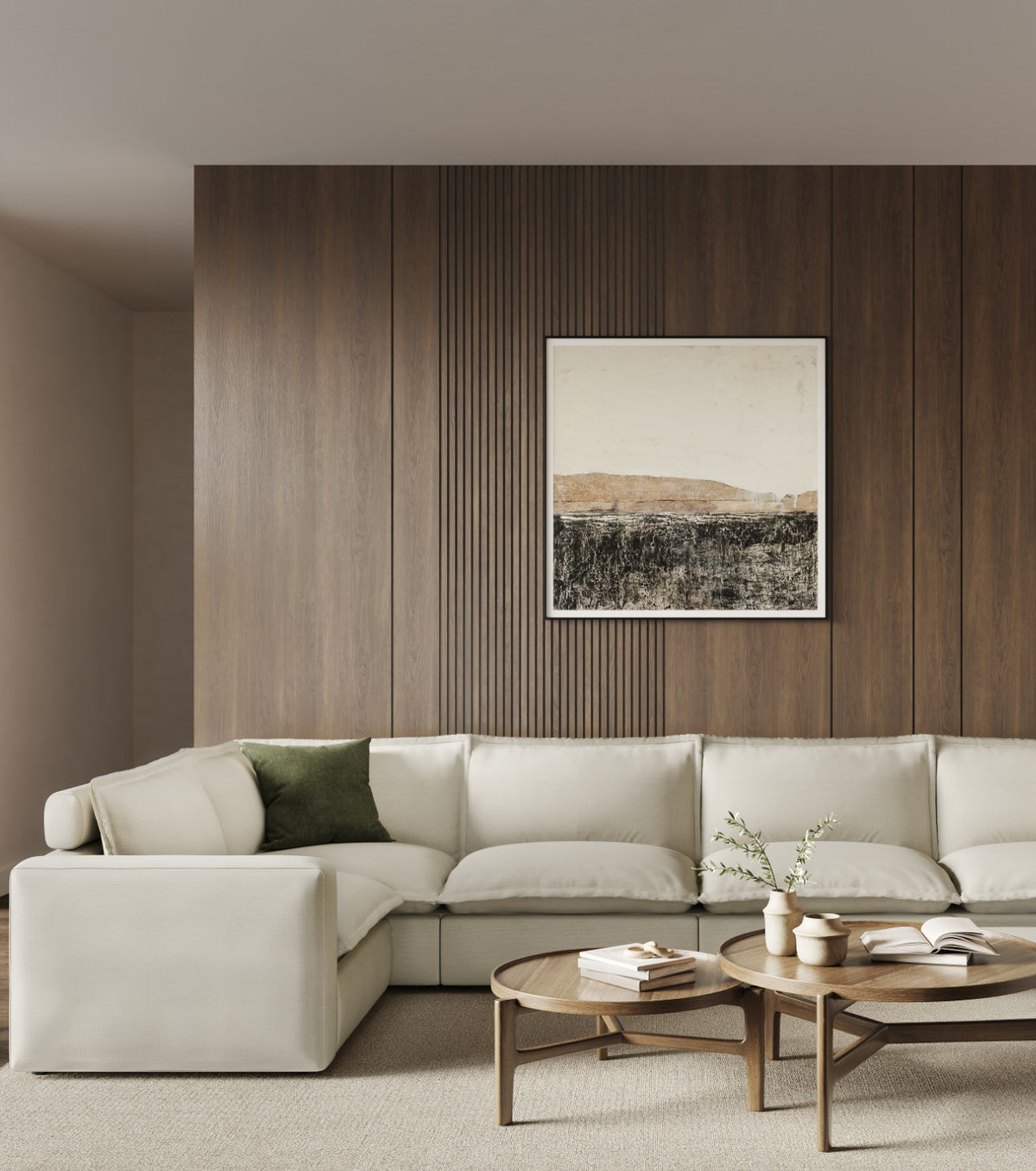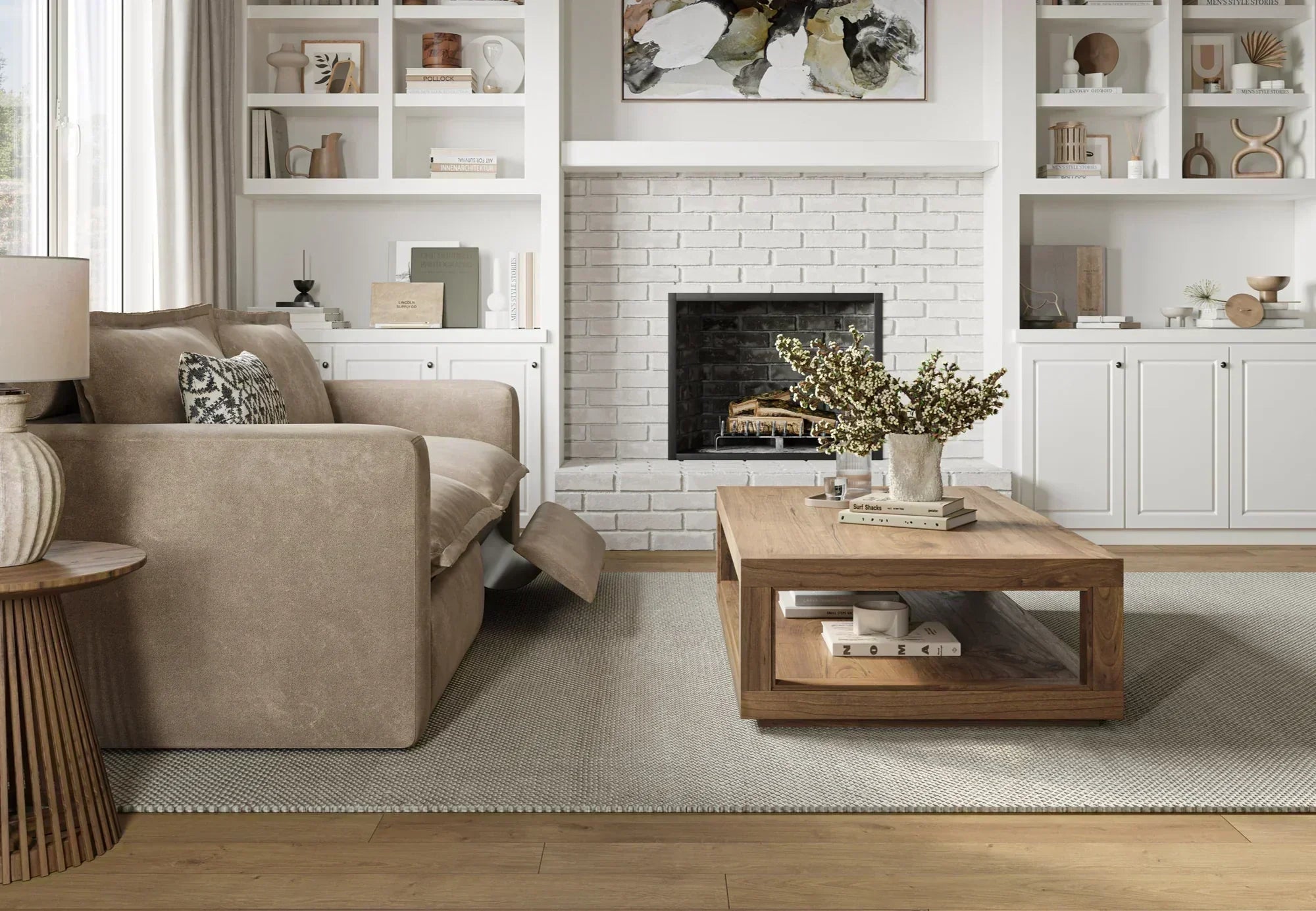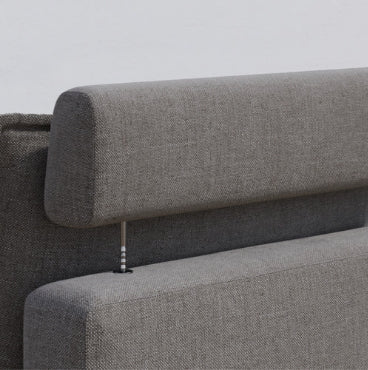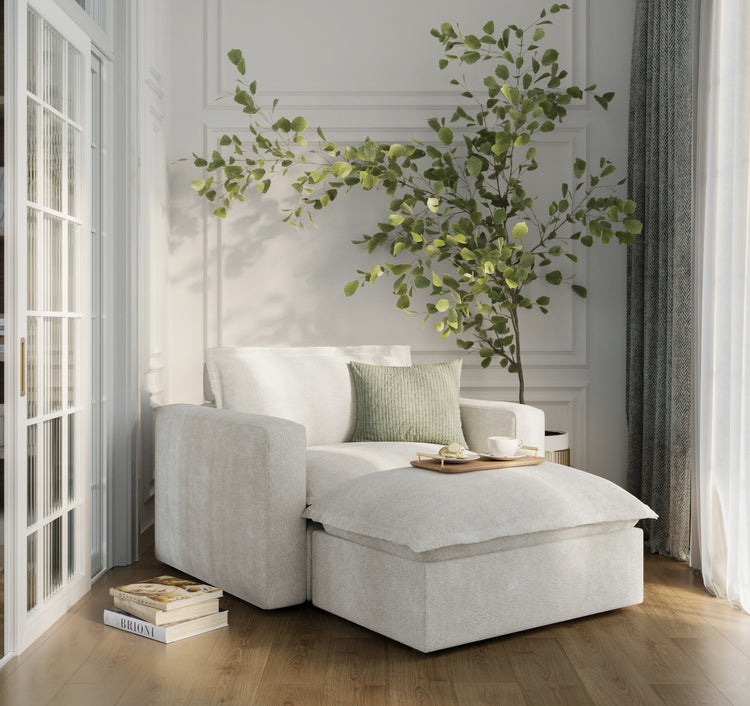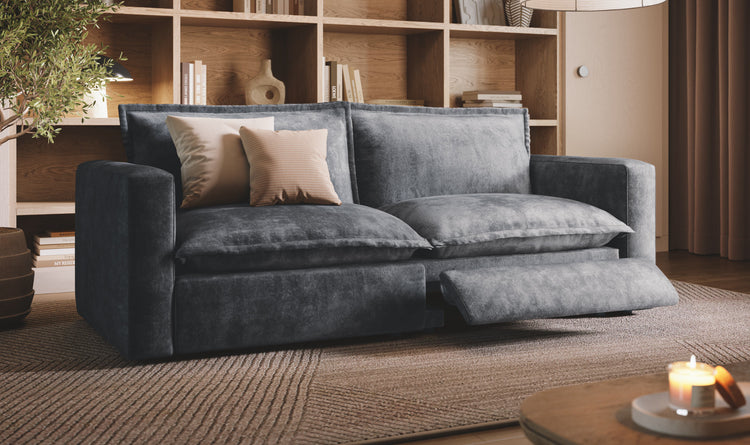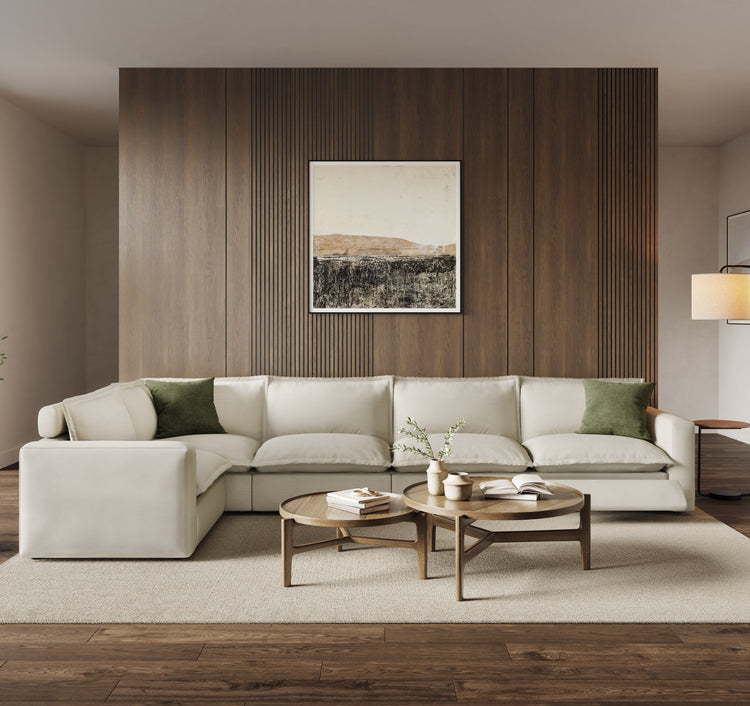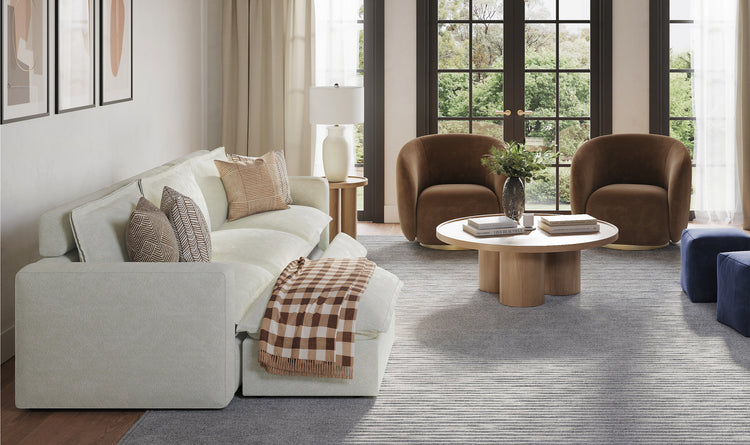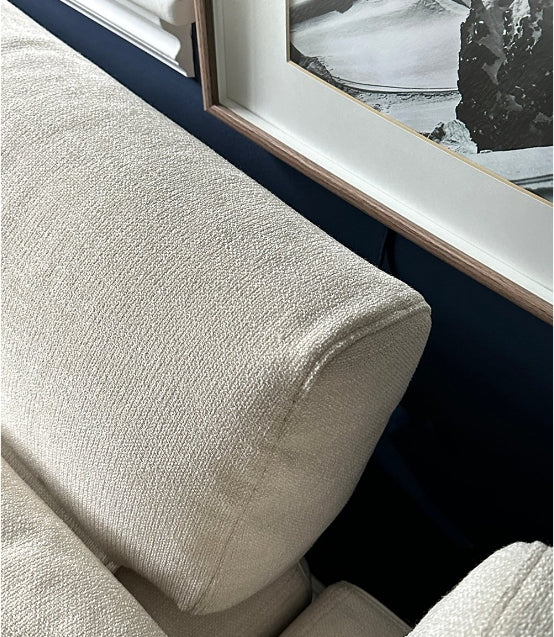If you have ever struggled to get a sectional couch into your living room, you are by no means the only one. Some sectionals in some spaces work and look fabulous and snug and planned out, but others are cramped and un-walk-around-friendly. These easy tips are for any sized room, whether you have a big living area or a small apartment that will make your couch shine.
Rule #1: Measure Your Space
Before falling in love with that perfect sectional, pick up your tape measure! The #1 thing people do wrong is purchasing a sectional that's too large for their room. Begin by measuring the length and width of your entire room, including doorways, windows, and other permanent features that restrict your furniture configuration.
Don't just tape off the floor space and don't forget ceiling height, especially if your sectional features a high back. Once you have your room measured out, have your painter's tape mark where the sectional would lay. This trick does you a big service because it lets you visualize the footprint and test whether you're still able to comfortably move around it.
Don't forget to leave a minimum of 18 inches between the sectional and coffee table for enough leg room, and 30-36 inches for main walkways throughout the room. Take these measurements first so you're not led astray by an expensive mistake and this way your new sectional enhances your space rather than overpowers it.
Rule #2: Prioritize Functionality
When integrating a sectional sofa into your living room, function needs to be a top priority. Here's how to make your sectional maximize the functionality of your space:
Conversation Areas
Place your sectional to provide natural conversation areas where individuals can conveniently interact without having to lean forward to see or hear one another. The L or U-shape configuration of sectionals naturally establishes these cozy group areas.

Entertainment Setups
Place your sectional with entertainment centers in the most desirable viewing positions. Consider sight lines to TVs or screens so that all seats are comfortable to watch without having to strain the neck.
Traffic Flow
Leave at least 30-36 inches of walkway space around your sectional for easy movement. Ensure pathways to doors, windows, and other high-traffic areas remain unobstructed.
Accessibility Considerations
- Position the sectional to allow easy access to entryways, windows, and other furniture
- Ensure side tables are within reach of seated guests
- Leave space for opening doors, drawers, and cabinets
Multi-functional Use
Consider how your sectional can serve multiple purposes—from daily lounging to entertaining guests or watching TV.
Rule #3: Create Balance and Flow
When incorporating a substantial piece like a sectional sofa into your living room, achieving visual harmony and maintaining easy movement throughout the space is essential.
Create a Balanced Look That Works
Counteract the visual weight of your sectional with strategically placed other furniture pieces. For sectionals that are L-shaped, put heavy components like bookshelves or console tables on the opposite wall. For U-shaped sectionals, position them in the middle of the room and then have balanced pieces on both sides.

Consider scale when selecting supporting pieces—oversized sectionals will pair well with big coffee tables, but little side tables and lamps could be overwhelming. Use the principle of asymmetrical balance by placing a single armchair opposite a sectional to create balance without perfect symmetry.
Keep Traffic Moving Through Your Room
Make open spaces of no less than 30 inches around your sectional so circulation is convenient throughout the room. Position your sectional to provide natural traffic flow about the seating area, not through it. Never obstruct doorways or natural pathways to other spaces.
Use Accessories to Complete Your Space
Anchor your sectional with an appropriately sized area rug—ideally 18-24 inches wider and longer on all sides of the sofa. Select a coffee table that approximates the shape of the sectional (rectangular for straight, round for curved) with 14-18 inches of leg space for comfort.
Layer lighting of different heights utilizing floor lamps sitting alongside the sectional and table lamps on side tables to create visual interest and effective lighting throughout the seating space.
Rule #4: Integrate with Decor
A sectional sofa represents a significant investment in your living space, making it crucial to harmonize this centerpiece with your overall design aesthetic. The key is creating a cohesive look that feels intentional rather than disjointed.
How to Match Your Sectional With Your Decor
Match your sectional to your existing decor style by considering its lines and proportions. For modern minimalist spaces, select clean-lined sectionals with metal legs and sharp corners. Traditional spaces are complemented by rolled arms, skirted bases, and tufted trim. Mid-century modern decor is complemented well by tapered wooden legs and soft organic curves.
The sectional's upholstery must complement your design language—leather for industrial or farm settings, performance fabrics for casual family rooms, and luxury fabrics such as velvet for formal rooms. If in doubt, neutral-colored sectionals possess the most versatility between design styles.

Choose Colors and Accessories That Work Together
Design your color scheme around your sectional, especially if it has a bold color. For neutral sectionals, introduce color through accent pillows, throws, and surrounding artwork. Create depth by incorporating various textures—pair smooth leather with nubby throws or flat-weave with plush pillows.
Accent pieces should complement and not detract from your sectional. Coffee tables, side tables, and ottomans must offer proportional ratios without adding materials other than complementary materials like wood, glass, or metal repeated in your design plan. Wall pieces positioned above your sectional must cross around two-thirds of the length of your sofa to produce visual harmony.
Your sectional needn't match everything perfectly—thoughtful coordination creates more sophisticated spaces than perfect matching sets.
Rule #5: Optimize for Comfort
The ultimate purpose of any sectional sofa is to provide a comfortable retreat for relaxation and socializing. Ensuring your sectional delivers comfort is essential for long-term satisfaction with your investment.
Make Your Sectional More Comfortable
Layer your sectional with a mix of cushions in diverse sizes and levels of firmness to accommodate differing comfort requirements. Position larger cushions (22-24 inches) on corners and smaller ones (18-20 inches) on straight sections. Include at least one lumbar pillow for perfect back support.
Throw some light throws over the armrests or corners so that they can be accessed comfortably during cold times, choosing seasonally—thin cotton for summer and heavy knits for winter.

Is Your Sectional Supporting You Properly?
Select sectionals with seat depths that suit your family's height—longer seats (22-25 inches) for taller individuals and shorter seats (20-23 inches) for shorter individuals. Select cushions with high-resilience foam cores covered in down or fiber fill for the optimal balance between support and softness.
Consider seat height (17-19 inches is generally most comfortable) and armrest height to ensure proper body positioning on extended seating periods.
5 Common Mistakes to Avoid
Even the most beautiful sectional can fail to deliver its full potential when common placement errors occur. Awareness of these pitfalls can save you from costly design missteps and functionality issues.
1. Undersized Room Selection
- Mistake: Forcing an oversized sectional into a space that's too small, leaving no room for movement or additional furniture.
- Solution: Always measure your space before purchasing and leave at least 30 inches for walkways. Consider apartment-sized sectionals for smaller rooms.
2. Wall Hugging
- Mistake: Pushing the sectional directly against walls on all sides, creating an institutional feel.
- Solution: Float your sectional at least a few inches from the wall, or position just one side against a wall to create a more intentional, designed look.
3. Blocking Natural Light and Views
- Mistake: Positioning tall sectional backs in front of windows, blocking light and outdoor views.
- Solution: Arrange the lower portions of your sectional near windows or choose lower-profile designs for rooms where natural light is at a premium.
4. Ignoring Scale Relationships
- Mistake: Pairing massive sectionals with delicate accent tables or tiny rugs that get visually overwhelmed.
- Solution: Select substantial coffee tables and appropriately sized rugs that extend beyond the sectional's footprint to create proper scale relationships.
5. Neglecting Conversation Dynamics
- Mistake: Arranging sectionals where people must strain to converse across large distances.
- Solution: Position seating elements within 8 feet of each other and angle conversation areas slightly inward to facilitate natural interaction.
Getting Your Sectional Sofa Just Right
Placing your sectional sofa is all about balancing both functionality and beauty in your room. If you follow our five simple rules—first measuring your space, then making sure it's functional, creating good balance, matching your decor, and focusing on comfort—you'll avoid missteps and end up with a better-working living room for everyday life. Take another look at your space with these tips in mind. Remove the measuring tape and try out some new configurations. Think ahead, and you may have a snug, lovely living room that operates wonderfully for your lifestyle and tastes.
